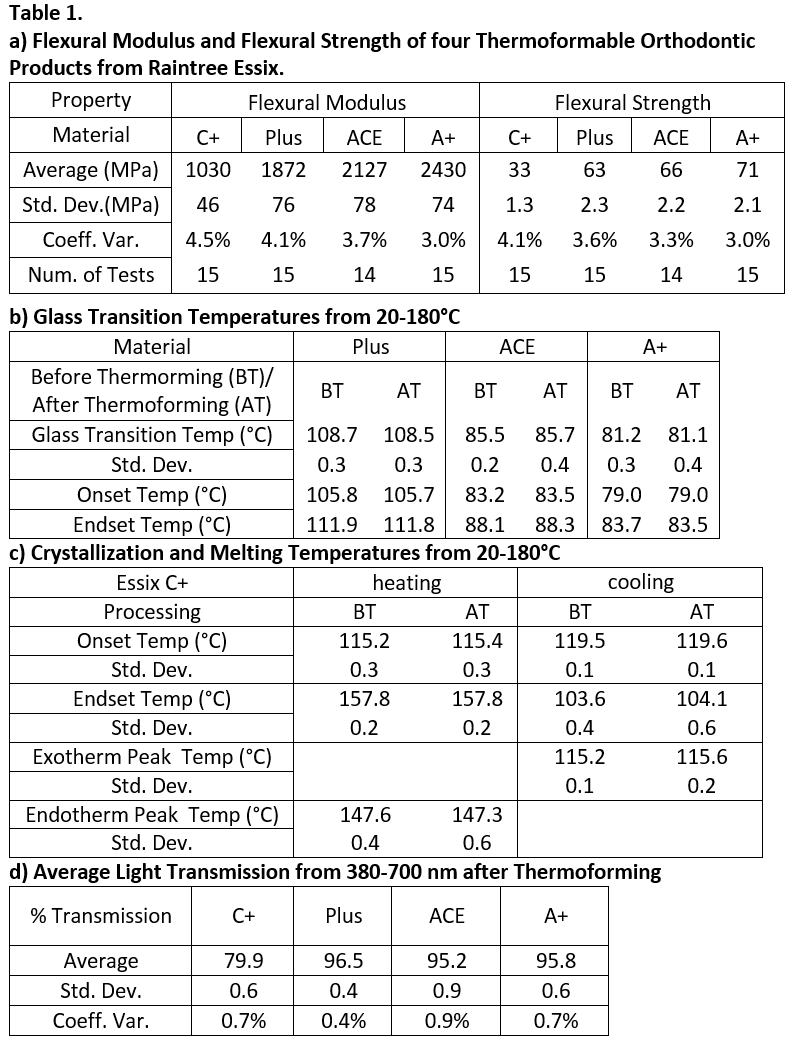IADR Abstract Archives
Physical and Thermal Behavior of “Clear” Plastic Orthodontic Materials
Objectives: Thermoplastic materials, which can be thermorformed into orthodontic appliances,are commonly used to address orthodontic misalignment. The objective of this study was to measure the physical and thermal behavior of four commercially available orthodontic materials.
Methods: Four orthodontic materials (Raintree EssixPlastic, Dentsply-Sirona) were evaluated in this study, as shown in Table1. Flexural-modulus and flexural-strength for each material was determined using a 3-point loading system on a mechanical-testing-machine (Instron5582). ProcedureA from ASTM D-790 was followed for materials with thicknesses less than 1.6mm. Specimens (50.8mmx12.7mm) were cut from nominal 1mm thick material after being thermoformed (Biostar,Scheu-Dental) over a fabricated aluminum mold. The specimens were loaded at a strain-rate of 1%/min on a 3-point loading apparatus with a support span of L=25.4mm and loading nose and supports having a radii of 3.6mm. Differential-Scanning-Calorimetry (DSC250,TA-Instruments) was performed to determine thermal behavior for the materials in the range of 20-180°C at 20°C/min for materials before and after thermoforming(N=10). Average light-transmission was also measured from 380-700nm using a spectrometer(Flame,OceanOptics)/ integrating-sphere (Labsphere Inc.) assembly.
Results: Table1a shows that the average flexural-modulus for the 4 materials ranged from a low of 1030MPa(C+) to a high of 2430MPa(A+). Likewise, the average flexural-strength ranged from a low of 33MPa(C+) to a high of 71MPa(A+). Testing for thermal behavior showed glass-transition-temperatures ranging from 81.1-108.7°C for the Plus, ACE, and A+ materials, as shown in Table1b. An endothermic-melting-peak of ~147°C and an exothermic-crystallization-peak of ~115°C were measured for the C+ material(Table1c). Table1d shows average light transmission values ranged from a low of 79.9% for the C+ to a high of 96.5% for the Plus.
Conclusions: The physical and thermal behavior of four thermoformable orthodontic materials were successfully characterized in this study, with the material with the highest mechanical strength and stiffness exhibiting values that were over twice as high as the material with the lowest values.
Methods: Four orthodontic materials (Raintree EssixPlastic, Dentsply-Sirona) were evaluated in this study, as shown in Table1. Flexural-modulus and flexural-strength for each material was determined using a 3-point loading system on a mechanical-testing-machine (Instron5582). ProcedureA from ASTM D-790 was followed for materials with thicknesses less than 1.6mm. Specimens (50.8mmx12.7mm) were cut from nominal 1mm thick material after being thermoformed (Biostar,Scheu-Dental) over a fabricated aluminum mold. The specimens were loaded at a strain-rate of 1%/min on a 3-point loading apparatus with a support span of L=25.4mm and loading nose and supports having a radii of 3.6mm. Differential-Scanning-Calorimetry (DSC250,TA-Instruments) was performed to determine thermal behavior for the materials in the range of 20-180°C at 20°C/min for materials before and after thermoforming(N=10). Average light-transmission was also measured from 380-700nm using a spectrometer(Flame,OceanOptics)/ integrating-sphere (Labsphere Inc.) assembly.
Results: Table1a shows that the average flexural-modulus for the 4 materials ranged from a low of 1030MPa(C+) to a high of 2430MPa(A+). Likewise, the average flexural-strength ranged from a low of 33MPa(C+) to a high of 71MPa(A+). Testing for thermal behavior showed glass-transition-temperatures ranging from 81.1-108.7°C for the Plus, ACE, and A+ materials, as shown in Table1b. An endothermic-melting-peak of ~147°C and an exothermic-crystallization-peak of ~115°C were measured for the C+ material(Table1c). Table1d shows average light transmission values ranged from a low of 79.9% for the C+ to a high of 96.5% for the Plus.
Conclusions: The physical and thermal behavior of four thermoformable orthodontic materials were successfully characterized in this study, with the material with the highest mechanical strength and stiffness exhibiting values that were over twice as high as the material with the lowest values.

